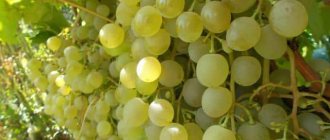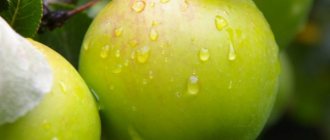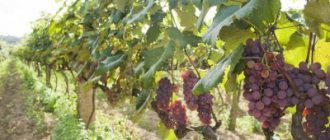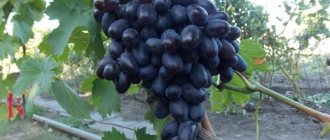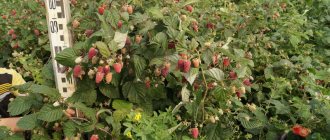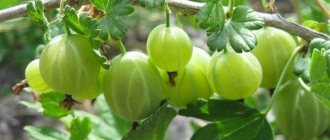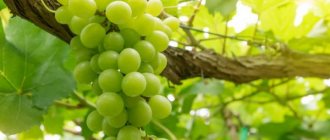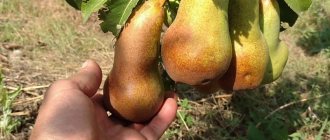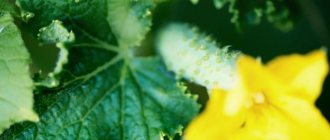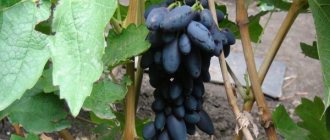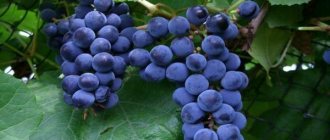What type does it belong to?
"Vodograi" is a table grape variety. It is remarkable for its excellent taste, excellent presentation and high yields. The variety is grown for fresh consumption and preservation. Table varieties include the well-known Korinka Russian, Lily of the Valley or Karmakod.
Vodograi berries give off a lot of juice, so they are quite suitable for wine production.
The transportability of the variety is average. The fruits are practically not damaged during transportation, but they tend to fall off the bunches.
Landing
In order for the vine to grow well and bear fruit consistently, planting seedlings must be taken with full responsibility:
- for the vineyard, choose a well-lit, dry and well-ventilated place with loose, fertile soil;
- groundwater should not approach the soil surface closer than 2 meters;
- the site is dug up in advance, cleared of weeds and roots, and fertilized;
- It is better to plant in the spring, after the soil has warmed up;
- the holes are prepared in the fall. The dimensions of the pits are 80 x 100;
- drainage (broken brick) is placed at the bottom, then a mixture of fertile soil and fertilizers is poured halfway, forming a small hill from this mixture;
- The seedling is placed on this hill, the roots are straightened, covered with soil and watered abundantly:
- To avoid rapid evaporation of moisture and the growth of weeds, the space around the plantings is covered with mulch - sawdust, straw, humus or peat.
Caring for plants is not difficult at all. Even beginners in viticulture can do this:
- Vodograi grapes, although drought-resistant, require constant watering. The first watering is done before the start of the growing season, and then the vine is watered as needed. During flowering, watering is stopped. In the fall, after harvesting, carry out abundant water-recharging irrigation;
- The grapes need to be fed 4 times per season. The first time this is done is early in the spring. Organic matter and nitrogen fertilizer are added. Then fertilizing is carried out before flowering. As soon as the fruits set, the plants are fed with phosphorus and nitrogen, and in the fall organic fertilizers are used again;
- for normal growth and fruiting, the vine must be tied to a support;
- the ground around the plants is periodically loosened to ensure oxygen access to the roots;
- to prevent disease, the soil around the vine is kept clean, free from weeds and cleared of organic residues;
- To avoid overloads, the variety requires crop rationing. To do this, the shoots are shortened by no less than 6-8 cm;
- Vodograi does not tolerate cold well, so it must be covered for the winter. The soil under the bush is covered with straw, the vine is carefully removed from the trellis, placed on the straw and covered with spruce branches or agrofibre, then sprinkled with earth.
Description of the grape variety Vodogray
“Vodograi” can be recognized by its surprisingly large, elegant clusters, the weight of which can reach up to 1 kg . The shape of the bunch is conical, dense, sometimes medium-dense. Amethyst Novocherkassk and Baikonur are distinguished by the same beauty of clusters.
Beautiful large oval-shaped berries
The pulp of the berries with thick skin is fleshy and very juicy with a subtle nutmeg flavor.
Weight reaches 12 g, length - up to 34 mm, and width - up to 20 mm. The acidity of “Vodograi” is from 6 to 7 g/l, and the sugar content is from 18 to 20 g/100 ml. The small leaves have a five-lobed, dissected shape. Annual ripened shoots are soft brown in color, and vegetative shoots are reddish-green.
The grape bushes are vigorous and have a three-tiered well-formed root system. Vigorous varieties also include Ataman Pavlyuk and Anthony the Great.
One of the advantages of this grape is its bisexual flowers, thanks to which “Vodograi”, like Ruta or Favor, does not need pollinating varieties and perfectly fulfills this role for other varieties.
Reproduction
Cuttings of the Vodograi variety have good rooting; in a school, usually all the seedlings are powerful and develop successfully. Cuttings also grow successfully with scions. Grape cuttings are cut in the fall, during pruning, and stored in damp cloth or polyethylene until February-March, the rooting period.
- Cuttings should be taken only from mature fruit-bearing vines;
- Cuttings are taken after the leaves fall;
- Select a straight piece of vine;
- It is better to cut the cuttings long, from 12-15 cm.
Rooting
In February or early March, Vodograi grape cuttings are taken out after storage and soaked for two days in clean water. Then the lower ends of the branches are placed in a solution of a growth stimulator in accordance with the instructions for the drug and planted. Special containers and substrate are prepared for chibouks. You can use plastic bottles of different sizes: 1.5 and 0.5 liters.
- A large bottle is cut off at the top in the shape of a glass, holes are made at the bottom for drainage, appropriate material is placed, and a 3-4 cm layer of garden soil is placed on top;
- The smaller bottle is cut off from the bottom and top, inserted into the larger one and soil is poured between their walls, compacting it well. The soil is watered. Instead of a bottle, you can take a small plastic cup, also removing the bottom;
- Sand is poured into a smaller bottle and watered. Then it is carefully removed;
- Make a hole in the sand for the cutting and plant it, leaving 2 buds above the substrate;
- The cut off top of the bottle is placed on top, which forms a mini-greenhouse;
- Vodograi grape cuttings are placed on the windowsill and watered every day. The top bottle is removed when the cutting produces its 4th leaf.
Attention! Green spring cuttings of grapes are also rooted before the flowering phase. They require less care, but should be planted as soon as possible after cutting.
Landing
Grape cuttings are planted in May. For the Vodograi variety, choose a sunny place, protected from the north wind, under the protection of buildings. Keep in mind that this is a vigorous form of the vine, the branches of which reach up to 4-5 m in length in both directions. The location of the protective box is also planned in advance if they are going to arrange this form of shelter for the Vodograi grape bush.
- When cutting cuttings in the fall, you can also prepare planting holes measuring 80 x 80 x 80 cm;
- Removing the top, fertile layer of soil, it is set aside separately and later mixed with the same amount of humus, 0.5 liters of wood ash, 70 g of superphosphate and 50 g of potassium chloride;
- Drainage is placed at the bottom, then the prepared substrate is placed and a Vodograi grape seedling is installed along with an earthen lump;
- The hole with the planted cuttings is not completely filled up; the seedling grows in a small depression, which after planting is filled with water and then mulched.
History of selection
“Vodograi” is considered one of the best in the collection of the Ukrainian breeder V.V. Zagorulko, who developed this wonderful variety by crossing “Kishmish radiant” and “Arcadia”.
Breeder Zagorulko is also the author of such varieties as Asya, Viking and Bazhena.
From its parents, “Vodograi” acquired a fairly early ripening period with not very high frost resistance . It belongs to the covering types of grapes.
The variety is successfully grown in the southern regions of Russia, Crimea and Ukraine. To cultivate Vodograi in mid-Russian latitudes, you will need careful shelter for the winter.
Reviews
Reviews from winegrowers about Vodograi are quite contradictory. On the one hand, everyone notes the beautiful appearance of the brushes and the pleasant taste. On the other hand, many are dissatisfied with the very mediocre resistance to frost and disease, and some criticize the thick skin, the shedding of berries from the ridges, their different sizes and the liquefaction of the pulp in some years.
According to the descriptions of farmers who have something to compare with, the described variety is inferior to Sofia and Libya by the same author.
Save the article:
Characteristics
"Vodograi" produces high, stable yields every year. Its fruiting coefficient is on average from 1.2 to 1.7 bunches. From the beginning of flowering to the full ripening of the fruit it usually takes about 125 days.
The shoots of the variety ripen almost completely. The clusters on the bush are quite heavy, which sometimes leads to overload of the vine. Therefore, it needs autumn pruning. When shortening, it is recommended to leave 4 to 8 buds on the vine. In grafting, Vodogray is well compatible with most rootstocks.
The frost resistance of the variety allows the grapes to withstand down to -21 ° C, so it requires mandatory shelter for the winter. To protect grapes from severe frosts, it is necessary to insulate them with polyethylene or sprinkle them with earth.
It is important to ensure that the vine does not come into contact with frozen soil in winter. To do this, you can use straw, burlap or any insulating material.
To improve the quality of “Vodograi” fruits, it is necessary to remove stepsons and shoots with weak growth, pinching them before flowering, rationing the yield and partially tearing off the leaves for free access of sunlight to the ripening berries.
The variety responds well to fertilizing with nitrogen and phosphorus-potassium fertilizers, which must be applied every year. In addition, “Vodograi” is a big lover of moisture.
Watering should be carried out before buds begin to open , before and after flowering, as well as before sheltering for the winter, not forgetting to mulch the soil.
Growing
In the first year of growth, a Vodograi grape seedling does not burden the gardener with a large amount of work. Loosening the tree trunk, removing weeds, watering and preventive treatments against diseases make up all the concerns. They leave one powerful shoot that rises up. Signal clusters appear in the 2-3rd year. A full harvest of Vodograi grapes is formed in the 4th year.
Watering
A seedling of the Vodograi variety is watered regularly in a circular furrow. To prevent the soil in the hole from drying out, mulch it.
- Mature vines are watered for the first time in a season even before the buds awaken so that the soil is moistened by 30 cm, 30-40 liters per Vodograi grape bush;
- The second watering of the grapes is carried out before flowering. Do not water during flowering to prevent the flowers from falling off;
- Water when the ovaries form;
- Summer watering is carried out in case of prolonged drought and berry growth stops;
- Before frost, in the fall, grapes need moisture-recharging watering - 40-50 liters per vine.
Top dressing
Grapes are fertilized only in the 4th-5th year of growth if the soil was enriched during planting.
- In the spring, after removing the shelter, each grape bush is fed with a solution of 10 g of ammonium nitrate, 20 g of superphosphate and 5 g of potassium chloride per 10 liters of water;
- The same composition is given before flowering;
- 2-3 weeks before the berries ripen, the vine is supported with superphosphate and a chlorine-free potassium preparation: 20 g per 10 liters of water;
- The Vodograi variety is also fed with this fertilizer after harvesting so that the vine is healthy in the pre-winter period.
Trimming
In autumn, grapes are cut into 4-6 eyes. In summer, the load is distributed according to the rule: 1 shoot - 1 bunch. In the middle zone, Vodograi grapes are best shaped like a fan, with the vine tilted at 45 degrees. It is better to bend it down for wintering. An adult bush can support up to 20 bunches with an average weight of 1 kg.
Protection
As a preventative measure, vines of the Vodograi variety, sensitive to mildew and oidium, are treated with fungicides Ridomil, Tilt-250, Cabrio Top and others. The acaricides Omite, Sunmite, Demitan will help against ticks.
Growing this table form of vine will beautify the yard and reward the efforts of a dedicated gardener with visible results of labor.
Diseases and pests
“Vodograi” is resistant to oidium and mildew. The degree of its resistance to disease is from 3.5 to 4 points. Nevertheless, preventive treatment will not hurt the plant. It will help the grapes protect themselves from other possible diseases.
Spraying the bushes with Bordeaux mixture and fungicides (Ridomil, TILT - 250) helps a lot. Plants should be treated twice - before flowering and after it.
From waterlogging or alkalization of the soil, grapes can develop chlorosis. This is due to the fact that the plant’s metabolism is disrupted, which causes yellowish stains and spots to form on the leaves.
The veins on the leaf blades continue to remain green. The growth of grapes with this disease is inhibited and in case of a large infection the bush may die.
in treating chlorosis :
- If the soil has excess moisture, it is drained.
- If the ground contains an excessive amount of lime, holes should be made near the bushes with a depth of 40 to 42 cm and a solution of antichlorosine should be poured into them (5 liters per bush). The leaves are also sprayed with it.
- If there is a lack of iron, the bush is treated with a solution of 0.5% iron sulfate. This must be done very carefully to avoid burning the vine.
- If grapes grow on sandy soil, to protect against chlorosis they are fertilized with manure diluted in two parts of water.
Another danger that may lie in wait for the Vodograi variety is grape mite . In case of mass destruction, this pest reduces yields by 50%. The mite is destroyed by treating the bush with a sulfur-containing preparation or pollination with sulfur. Treatment is carried out twice with an interval of 10 days.
If preventive treatment against oidium has been carried out in the vineyard, grape mites, as a rule, do not appear.
During the period of fruit ripening, juicy and aromatic “Vodograi” attracts birds and sweet-toothed wasps , which can spoil a significant part of the harvest. To protect against bird attacks, you can stretch strong threads over the bushes, install rattles or mirror balls in the area, but such methods are not always effective.
There is a very good way to protect the crop - it is necessary to provide the birds with clean water in a timely manner. In spring or June, you need to place drinking bowls around the grape bushes.
The birds develop the habit of drinking water from drinking bowls and leave the grapes untouched. This measure will also help in protecting the crop from wasps, since insects themselves are not able to bite through the dense skin of the fruit and only eat them that have already been damaged by other pests, for example, birds.
In the fight against wasps, you need to regularly go around their favorite places of settlement: holes in the fence, trellis pipes and other places. Wasp nests are destroyed with insecticides or burned.
Traps with small holes and sweet syrup inside are very effective in fighting wasps. And the best way to protect the crop is considered to be special bags placed on the ripening bunches.
Agrotechnical features
The economic characteristics of Vodograi look quite good in many respects, but some of them do not allow us to call it a highly resistant and extremely unpretentious grape. Therefore, in order to obtain high yields of good quality, the winegrower will have to take into account the specifics of the variety and competently level out its flaws in agrobiology.
The planting of a vineyard should be carried out according to generally accepted cultural principles. The hybrid does not show any special features in this regard. For planting, the warmest places are selected in the upper part of the slopes with warm exposures, and if we are talking about country houses, garden plots and personal plots, then in case of a risk of insufficient SAT levels, the bushes are placed under the protection of various buildings on their southern side. Cold slopes, beams and valleys are unacceptable for grapes. It is desirable that the soil moisture supply is sufficient; both a lack and an excess of moisture will not allow plants to develop normally. Soil fertility may vary, but if its level is low, special care should be taken to ensure the availability of mineral nutrition for young bushes in the first years of their development, through regular fertilizing.
Rules for planting and caring for Meyer lemon varieties at home, secrets of growing
The phylloxera resistance of Vodograya is not known for certain, and therefore, in order to avoid unnecessary disappointments, its planting in phylloxera-infected regions is carried out with grafted seedlings, for which special resistant varieties are used as rootstocks. This method of propagation, although it is more complex than the root method, nevertheless guarantees normal development and long life even for grape varieties that are highly susceptible to root aphids. Our hero can take root on his own, but planting it in this form is only possible in areas that are guaranteed to be free from phylloxera.
Almost everywhere, with the exception of the mild subtropical climate on the Black Sea coast, the cultivation of this hybrid form is possible only in a cover culture, for which Vodograi bushes from the first years of life are formed according to special squat patterns like Guyot, a multi-armed fan or an oblique cordon. They allow you to remove and return the vine to the trellis without much damage. The shelter is made both with soil from the rows and with available insulating materials - straw, peat, spruce branches, reeds, etc. Tunnel film shelters are also often used. The choice of method depends primarily on the frost danger of a particular region.
Rationing the load on a variety is one of the main measures in a vineyard that has entered fruiting. In this case, to obtain optimal results, spring pruning of fruit shoots is carried out by 4-8 buds, with a total load per bush of 30-35 buds. After the grape shoots begin to develop, the fruitless and weak ones are broken off, so that 20-24 fruitful vines remain on the plant. The inflorescences on them are also thinned out, observing the rule of 1 shoot - 1 bunch, making exceptions only for the most powerful of them, on which two brushes can be left.
In terms of disease resistance, Vodograi is at an intermediate level between susceptibility and tolerance, which, of course, is better than the classic “noble” varieties, but still not enough to avoid repeated chemical treatments. To maintain good phytosanitary condition of grape bushes, up to 4-6 fungicide sprayings will be required per season, depending on the weather conditions of a particular year.
